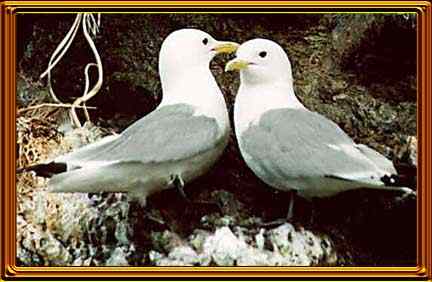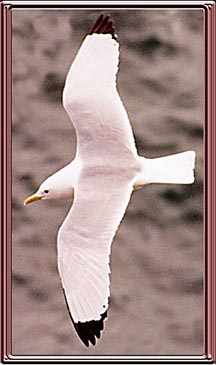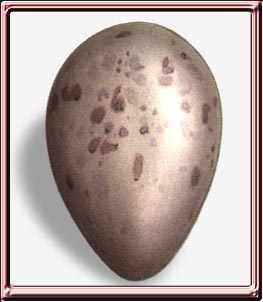
(The Kittiwake)
The Kittiwake is a bird of the rocky cliffs and stacks of the north and west coasts, being abundant in suitable districts of Scotland and Ireland and also plentiful though very local along the coasts of Wales and of Western England. On the east coast they do not breed south of the Humber, probably because of the lack of suitable sites. They are among the smallest members of the family, being scarcely larger than the Black Headed Gulls and are also the most truly oceanic, for except in the summer months they frequent the open seas well away from land.The plumage is white with a soft grey mantle and has plain black wing tips which form a triangle (see picture below) and unspotted by white "mirrors". The legs are nearly black and the bill is greenish-yellow.
Biology:
Size: Kittiwakes attain the length of 16 inches.
Habitat: The ocean, coasts and isles.
Nest: Nesting is carried out in large colonies, and the birds congregate in March and early April. These sites are crowded with birds and the nests are usually placed on ledges or in crevices. So narrow are some of these , and so apparently flimsy are the nests, that the latter appear to be in constant danger of blowing away or being knocked down onto the rocks below. In fact, the nest is a very strong structure of grass and seaweed mixed with mud and clay, the whole being trodden together to form a firm base. On this more seaweed and grass are heaped until the cup for the eggs rests on a large mass, but many nests are quite compact.
Eggs: The Kittiwake lays a single clutch of eggs comprising 2 to 3 eggs, these are usually laid in May though some have been known to be as late as the first weeks in June. The background colour is lighter than most of the other gulls, being normally a greyish-stone or buff. The markings of the specks, spots and blotches are grey and a dark reddish-brown, and , although varying a little in number, are seldom very dense, but may be grouped in zones.
Food: Small fish, crustaceans, etc. Besides surface feeding , it dives and swims under water after fish.

